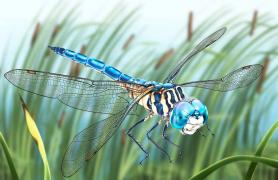
Humans have five senses: sight, smell, taste, touch, and hearing. But our senses are pretty puny compared to some wild critters.
Butterfly
What if your feet could taste your sweaty gym shoes? Yuck! Well, it’s a good thing butterflies don’t wear shoes because they have “tongues” on their toes. When a butterfly lands on a flower, its feet tell it in an instant whether there’s nectar to sip or if the plant is a safe place to lay eggs.
Timber Rattlesnake
To beat summer’s heat, timber rattlesnakes hunt at night. Finding dinner in the dark is easy. Like all of Missouri’s venomous snakes, rattlesnakes have built-in night-vision goggles. Special organs in pits between their eyes and nostrils help them “see” heat from other animals. Even in complete darkness, a rattler can detect a mouse 2 feet away and strike with deadly accuracy.
Bat
Bats bag bugs by “seeing” with sound. As they fly, they send out high-pitched squeaks — up to 200 each second! By listening to the squeaks echo off objects, bats create a mental image of their surroundings so they can zero in on tasty moths and mosquitoes. The process, called echolocation (eck-oh-loh-kay-shun), is similar to the sonar that submarines use to navigate underwater.
Bobolink
If you’re lost, it helps to have a compass. Birds, which travel great distances during migration, have them built in. For example, bobolinks have tiny bits of metal in their beaks. Earth’s magnetic field tugs on the metal, which tells the feathered wanderer which direction it’s going. Biologists have found proteins in some birds’ eyes that might allow them to actually see Earth’s magnetic field — sort of like a heads-up GPS display in a fighter jet.
American Paddlefish
So what’s with the big nose? Despite what you might think, an American paddlefish’s super-sized snout isn’t used for smell. Paddlefish eat tiny crustaceans, insects, and other animals that drift in the water as plankton. All living creatures — even tiny ones — emit weak electrical signals. A paddlefish’s snout acts like a TV antenna to detect those signals, which helps the fish zero in on clouds of yummy plankton.
Catfish
Every millimeter of a catfish’s skin, from its whiskery barbels to the tip of its tail, is covered with taste buds. If you were a catfish, you could taste a cookie just by touching it! But this sense-sational skin isn’t made to savor flavors. It helps a catfish find food in dark, murky water.
Luna Moth
When a lady luna moth is looking for love, she releases powerful perfumes called pheromones (fair-uh-mones). If a male moth is nearby, he’ll follow the scent. But he won’t use his nose — moths don’t have noses. Instead, he’ll use his fancy, feathery antennas to track her down. And they work really well! The antennas are so sensitive, a male moth can “smell” a female 2 miles away.
American Kestrel
American kestrels, like most birds, can see ultraviolet light. Voles — small rodents that kestrels love to gobble up for snacks — mark their trails through the grass with dribbles of urine. To humans, the urine is invisible. But because it reflects UV light, to a kestrel it looks like the neon sign at a diner, pointing the way toward dinner.
Scorpion
Who knew scorpions had a sensitive side? If you flip one over (we don’t advise it), you’ll find two comblike organs on its belly. These are called pectines (peck-teens), and they help a scorpion smell and taste its environment. In addition, sensitive hairs on a scorpion’s pincers feel vibrations in the air. These extra organs are important. Even though scorpions have eyes on both their backs and heads, they can’t see squat.
Bumblebee
When a bumblebee flaps its wings, the fuzz on its body becomes charged with static electricity. A flower swaying in the wind takes on a static charge, too. So when the bee lands on the flower, it gets a tiny zap of static. (The same thing happens when you shuffle in socks across a carpet and touch a doorknob.) If the bee doesn’t feel a zap, it knows another insect has already visited the flower. Shocking, huh?
Prairie Lizard
Almost all animals with four legs have two eyes. But some amphibians and reptiles, like this prairie lizard, have three. The parietal (pair-eye-it-uhl) eye sits in the middle of the lizard’s head and is covered with a scale. And though this third eye can’t see anything, it’s important. It sets the lizard’s internal clock, tells the lizard’s body when to produce important chemicals, and helps the lizard find its way around unfamiliar terrain by using the sun as a waypoint.




















Also In This Issue

The Blue Dasher

Wild animals don’t go to high school, of course. And they definitely don’t have yearbooks. But what if they did? With the end of the school year on the horizon, we thought it would be fun to imagine who might be top of the class at Critter High.
And More...
This Issue's Staff
Photographer – Noppadol Paothong
Photographer – David Stonner
Designer – Marci Porter
Designer – Les Fortenberry
Art Director – Cliff White
Editor – Matt Seek
Subscriptions – Laura Scheuler
Magazine Manager – Stephanie Thurber






















